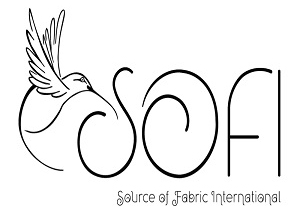If you’re a DIY enthusiast or a seasoned seamstress, finding the right fabric can make all the difference in your projects. With the rise of online shopping, you can now explore a world of textiles right from your couch. The convenience of browsing through countless options without the constraints of store hours is a game changer.
Understanding Your Fabric Needs
Understanding your fabric needs is crucial for successful DIY projects and sewing. Identifying the right types of fabric ensures that your final product meets your expectations.
Choosing the Right Fabric Type
Choosing the correct fabric type impacts the look and functionality of your project. Several common fabric types include:
- Cotton: Ideal for garments and quilts because of its softness and breathability.
- Linen: Suitable for summer clothing thanks to its light weight and moisture-wicking properties.
- Wool: Best for cold-weather items like coats or blankets; known for its warmth and durability.
- Polyester: Often used for its wrinkle resistance and durability in everyday clothing.
- Silk: Provides luxury for evening wear, offering a smooth touch and beautiful drape.
Consider specific qualities you desire for your project. For instance, if making a dress, look for lightweight fabrics that drape well. If crafting a tote bag, opt for sturdier materials like canvas or denim.
Identifying the Purpose of Your Fabric Purchase
Identifying the purpose behind your fabric purchase guides your selection process. Define the end use of your fabric by answering these questions:
- What will you create? Knowing if you plan to sew clothing, home decor, or crafts will influence your choices.
- What conditions will it face? Consider durability for items like bags or clothing that will undergo wear and tear.
- What is your budget? Some fabrics like silk are pricier than cotton; knowing your budget helps narrow options.
Assigning a purpose to your fabric encourages thoughtful choices. For example, if creating children’s clothing, prioritize washable and durable fabrics to withstand play and frequent washing.
Best Places to Buy Fabric Online
Finding quality fabric online simplifies the process of gathering materials for your sewing projects. Various options cater to different needs, styles, and budgets.
Major Retailers
- Joann Fabrics: Joann offers a wide selection of fabric types including cotton, fleece, and upholstery. Frequent sales and coupons contribute to its affordability. The website features a user-friendly interface, making it easy to browse by type or pattern.
- Fabric.com: Known for its extensive inventory, Fabric.com stocks a variety of fabric brands and types. You can find everything from quilting fabric to outdoor materials. Bulk purchasing options provide savings for larger projects.
- Mood Fabrics: Popularized by television, Mood is renowned for high-quality materials perfect for fashion sewing. A large selection includes unique and designer fabrics. Online shopping provides access to additional exclusive patterns.
- Spoonflower: Spoonflower stands out with its custom fabric printing service. You can upload your designs or choose from thousands of artist-created patterns. This option is ideal for personalized projects.
- Hobby Lobby: Hobby Lobby offers diverse fabric options suitable for crafts, home decor, and clothing. Regular discounts and weekly sales can lead to significant savings.
- Online Fabric Store: This retailer focuses on timeless classic and modern fabric styles. With a variety of fabric types available, it caters to both the novice and expert sewist. A clear search feature makes finding specific materials simple.
These major retailers provide a range of fabrics and prices, ensuring you can find the perfect materials for your next sewing project.
Specialty Shops
Specialty shops provide unique fabrics and supplies. These stores often focus on specific types of materials or styles, offering what larger retailers may not.
Mood Fabrics
Mood Fabrics stands out as a go-to option for quality and variety. This store offers a vast selection of textiles that cater to both casual crafters and professional designers. You can find fabrics for fashion items, home decor, and more. The well-known fabric retailer features a chic online layout that simplifies browsing. You can filter by fabric type, color, and price range, making the search process quick and efficient. Regular sales and discounts enhance overall affordability. Additionally, their fabric guides provide helpful information for selecting the right material for your projects.
The Fabric Store
The Fabric Store features a blend of modern and vintage textiles. This shop emphasizes natural fibers, ensuring sustainable options for eco-conscious shoppers. Bountiful choices exist in cotton, linen, and wool, along with an appealing array of designer fabrics. Shopping at The Fabric Store means access to both basic and specialty items. You benefit from detailed descriptions and high-quality images, allowing for informed decisions. Their strong commitment to customer service includes responsive support for inquiries. Regularly updated blog content offers DIY project ideas and fabric trends, making it easy to stay inspired.
Etsy
Etsy excels as a marketplace for handmade and unique fabric offerings. You can find a diverse range of sellers providing everything from vintage textiles to custom prints. This platform enables you to purchase materials directly from creators. The unique selection fosters a sense of connection with the artists behind the fabric. You can search by fabric type, color, or seller rating, ensuring a variety of options for any project. The reviews provide insight into quality and service levels across different sellers, enhancing your buying experience. Shopping on Etsy promotes supporting small businesses while acquiring memorable fabric choices.
Discount and Budget-Friendly Options
Finding budget-friendly fabric options online allows you to complete projects without overspending. Several resources offer quality textiles at reasonable prices, making it easier to stick to your budget.
Online Fabric Shops
Online fabric shops often host sales and provide discount offerings, making them ideal for budget-conscious shoppers. Websites like Fabric.com feature a clearance section that includes a range of fabrics at reduced prices. Joann Fabrics frequently runs promotions, providing additional savings on already affordable items. Sewing.org also lists coupons and discounts for various online fabric retailers, ensuring you save money on the materials you need. Most shops allow you to browse by clearance or sale sections, enabling easier access to discounted fabrics.
Thrift Stores with Online Presence
Many thrift stores now offer online options, expanding their reach to customers. Stores like Goodwill provide an online platform where you can find thrifted fabric and sewing materials at a fraction of the original price. Etsy features a section for vintage fabrics, where you can discover unique pieces that fit different styles and projects. When purchasing, you often contribute to local charities while finding budget-friendly fabric options. Always check the shipping costs to determine if they fit within your budget. These thrift opportunities can yield unique materials for your sewing projects without breaking the bank.
Assessing Fabric Quality
Assessing fabric quality plays a crucial role in ensuring satisfaction with your purchases. Understanding the characteristics of fabrics helps you make informed decisions.
Reading Customer Reviews
Reading Customer Reviews offers valuable insights into fabric quality. Look for detailed feedback on texture, durability, and overall satisfaction from previous buyers. Frequent mentions of softness, breathability, and print clarity indicate high-quality products. Check the number of reviews to get a sense of general consensus among buyers. Consider both positive and negative feedback, as this provides a balanced view of the product. If multiple reviewers mention issues such as pilling or fading after washing, exercise caution. Seek patterns in the comments to identify recurring strengths and weaknesses. High ratings and satisfied customer feedback usually correlate with quality assurance from online fabric sellers.
Understanding Fabric Specifications
Understanding Fabric Specifications ensures you choose the right material for your project. Key specifications include fabric weight, fiber content, and weave type. Fabric weight, usually measured in grams per square meter (GSM), affects how the material drapes and feels. Lighter fabrics work well for summer clothing, while heavier options are suitable for outerwear and upholstery. Fiber content impacts durability and care; for example, cotton is generally breathable and easy to wash, while silk offers a luxurious finish but requires special care. Investigate the weave type too; twill fabrics exhibit durability while knits provide stretch. Knowing these specifications helps you select fabrics that match your project’s needs and ensures successful outcomes.
How to Ensure Safe Online Shopping
Ensuring safety while shopping online is crucial for securing your personal information and making informed purchases.
Checking Website Security
Check the website’s security measures before entering any personal information. Look for “https://” in the URL, indicating a secure connection. Websites with this prefix employ encryption to protect user data. Always look for a padlock icon in the browser’s address bar as an additional sign of security. Avoid purchasing from sites without these indicators.
Research customer reviews and ratings of the website to gather insights about its reliability. Trustworthy websites typically demonstrate a solid reputation within user communities. Verify that the site has clear contact information, including a physical address and customer service number.
Utilize third-party services to confirm website security. Websites like Trustpilot or the Better Business Bureau provide ratings and feedback on businesses. Using these tools enhances confidence in your shopping experience.
Understanding Return Policies
Understanding return policies is essential for avoiding issues after your purchase. Read the return policy section on the website prior to buying. Look for details about time frames, conditions for returns, and who bears the shipping costs.
Opt for retailers offering flexible return policies. Policies that allow returns within 30 days provide safety if the fabric does not meet expectations. Make note of specific conditions, such as unopened fabric or tags still attached, as they can affect your ability to return items.
Keep all order confirmations and receipts in case you need to return items. This documentation supports your claim if any issues arise. When necessary, contact customer support for clarification on return processes and any ambiguities in the policy.
Informed shopping and understanding procedures enhance your online experience and protect your interests.
Tips for Successful Online Fabric Shopping
Measuring and Calculating Yardage
Accurate measuring directly impacts your fabric purchase. Determine your project’s fabric requirements by using a clear pattern or project plan. Calculate the yardage by measuring lengths and widths for each piece. Account for seam allowances and any design features like pockets or pleats. Use a yardstick or measuring tape for precision. For example, if a project requires a 60-inch width and a length of 2 yards, you need a total of 2 yards. Consider fabric repeats for patterned textiles as this can influence how much yardage to buy. Online calculators specifically for fabric yardage can simplify these calculations.
Ordering Swatches
Ordering swatches provides tangible insight before committing to larger purchases. Select a few fabrics that interest you and request samples. Evaluate the texture, weight, and color in person. Think about how these fabrics feel in use as this can greatly affect your final product. Many retailers offer free or low-cost swatches to help you decide. For example, if you are unsure about a satin’s sheen or a cotton’s softness, obtaining a swatch can clarify these attributes. Document your findings by taking notes on each swatch to compare options while shopping.
Keeping an Eye Out for Sales
Monitoring sales can significantly reduce costs. Many online fabric shops launch seasonal promotions or clearance events. Subscribe to newsletters from your favorite retailers to receive alerts on upcoming deals. Follow social media accounts for exclusive offers or flash sales. For instance, Joann Fabrics often runs weekend discounts, while Fabric.com features a clearance section. Compare prices between stores when searching for specific fabrics to secure the best deal. Plan your purchases around these sales for better savings on materials.
Troubleshooting Common Issues
Fabric shopping online can sometimes lead to challenges. Understanding how to handle these common issues enhances your experience and ensures successful purchases.
Receiving Poor Quality Fabric
Receiving poor quality fabric occurs occasionally when shopping online. Focus on checking customer reviews prior to purchasing. Reviews often provide valuable insights into fabric texture, durability, and overall satisfaction. Prioritize ratings of 4 stars and above for higher quality assurance. Investigate the fabric specifications listed by the retailer, such as fiber content and weight. If the fabric received fails to meet expectations, follow the retailer’s return policy. Contact customer service promptly to address your concerns. Keep all order confirmations and photos of the fabric as proof. This practice facilitates smooth communication and may expedite the return process.
Order Delays
Order delays frequently happen during peak shopping times or due to unforeseen circumstances. Check the estimated delivery date immediately upon placing your order. This information allows you to set realistic expectations. If a delay occurs, track your order using the provided tracking number on the retailer’s website. Reach out to customer service for updates if tracking information lacks clarity. In case of significant delays, inquire about cancellation possibilities, particularly if materials won’t arrive in time for your project. Staying informed helps manage any disruptions.
Wrong Fabrics Sent
Receiving wrong fabrics can lead to frustration. Verify that you ordered the correct fabric by cross-referencing your order confirmation. If incorrect items arrive, compare them with your order details. Contact customer service and explain the error. Take clear photos of the items received and include them in your correspondence for better support. Retailers often have a customer-first approach and may offer replacements or refunds. Return policies play a crucial role in resolving these issues, so familiarize yourself with them ahead of time.
By addressing these common issues directly, you enhance your overall online fabric shopping experience.
Conclusion
Finding the right fabric online can elevate your DIY projects and sewing endeavors. With a variety of retailers at your fingertips you can easily access everything from budget-friendly options to high-quality materials. Take the time to explore different shops and understand your fabric needs to ensure your projects turn out just as you envision.
Remember to read customer reviews and check return policies to make informed decisions. By following the tips outlined in this article you’ll navigate the online fabric shopping landscape with confidence. Embrace the convenience of online shopping and enjoy the creative possibilities that await you. Happy sewing!
Frequently Asked Questions
What should I consider when choosing fabric for my DIY project?
When selecting fabric, it’s essential to understand your project’s purpose, the conditions the fabric will encounter, and your budget. Each fabric type has specific qualities, like durability and texture, that fit different uses. Knowing these factors helps ensure that your final product meets your expectations.
Where can I buy fabric online?
You can purchase fabric online from major retailers like Joann Fabrics, Fabric.com, Mood Fabrics, Spoonflower, Hobby Lobby, and Online Fabric Store. Specialty shops focused on unique materials, as well as platforms like Etsy, also offer diverse options for fabric shopping.
How can I find budget-friendly fabric options online?
To find budget-friendly fabric, check for sales, clearance sections, and discount offers on websites like Fabric.com and Joann Fabrics. Thrift stores like Goodwill often have online shops, and Etsy features vintage fabric listings at lower prices, making it easier to stick to a budget.
How do I ensure fabric quality when shopping online?
Read customer reviews to gain insights into the fabric’s texture, durability, and overall satisfaction. Additionally, understanding specifications like weight, fiber content, and weave type can help you choose high-quality materials that match your project’s needs.
What are safe online shopping practices for fabric?
Ensure safe online shopping by checking for “https://” in the URL and a padlock icon for website security. Research customer reviews for reliability and make sure to understand a retailer’s return policy to avoid issues after your purchase.
How can I manage common issues during online fabric shopping?
To manage issues, read customer reviews to avoid poor-quality fabric, track your order to handle delays, and verify your order details promptly. If discrepancies arise, contacting the retailer quickly can help resolve issues with incorrect items.
Should I order fabric swatches before purchasing?
Yes, ordering swatches is a smart idea. Swatches allow you to evaluate the texture, weight, and color of the fabric before committing to larger purchases. This helps you make informed decisions and ensures the fabric will meet your project’s requirements.
How can I calculate the right amount of fabric I need?
To calculate yardage, measure your project dimensions accurately and consider your design’s pattern layout. Using a fabric calculator online can help you determine the amount needed based on those measurements and your specific project requirements.


